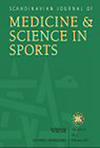The Effect of 90 and 120 Min of Running on the Determinants of Endurance Performance in Well-Trained Male Marathon Runners.
IF 3.8
2区 医学
Q1 SPORT SCIENCES
引用次数: 0
Abstract
The combination of maximal oxygen uptake (V̇O2max), fractional utilization at lactate threshold (FULT), and running economy (RE) is considered to largely determine/predict marathon performance, which is also closely associated with the speed at lactate threshold (sLT). Although these determinants are considered to deteriorate during prolonged running, except for RE, their temporal changes with fatigue remain largely unknown. This study aimed to measure the changes in V̇O2max, FULT, RE, and sLT after running for 90 and 120 min in the heavy-intensity domain. Fourteen trained marathon runners (V̇O2max 63.1 ± 5.8 mL·kg-1·min-1; marathon time 2:46:58 h:mm:ss) completed three separate visits to determine sLT, FULT, and V̇O2peak in the following conditions (sessions): unfatigued, and after two prolonged runs of 90 and 120 min at a fixed speed (10% Δ between LT and lactate threshold 2). During the runs, respiratory gases were collected at 15 min intervals to quantify RE. Decreases in V̇O2peak (-3.1%, p = 0.04 [post-90]; -7.1%, p < 0.001 [post-120]) and subsequent increases in FULT (+2.8%, p = 0.03 [post-90]; +4.9% p = 0.01 [post-120]) both occurred at an increasing rate with run duration, with FULT changes linked to the decreased V̇O2peak, while RE (mL·kg-1·km-1) deteriorated more linearly with time (by 4.2% [post-90] and 5.8% [post-120], p < 0.001). sLT also showed a nonlinear decrease, from 14.0 to 13.5 (p = 0.01 post-90), to 13.0 km·h-1 (p < 0.001 post-120). In conclusion, performance determinants and sLT changed following 90 min, and particularly 120 min of prolonged running. These dynamic changes have strong implications for running performance and would particularly affect longer duration events such as the marathon.90和120分钟跑步对训练有素的男性马拉松运动员耐力表现决定因素的影响。
最大摄氧量(V * O2max)、乳酸门槛分数利用率(FULT)和跑步经济性(RE)的组合被认为在很大程度上决定/预测马拉松成绩,这也与乳酸门槛速度(sLT)密切相关。尽管这些决定因素被认为在长时间的跑步过程中会恶化,但除了RE之外,它们随疲劳的时间变化在很大程度上仍然未知。本研究旨在测定高强度运动90min和120min后,大鼠的V * O2max、FULT、RE和sLT的变化。14名训练有素的马拉松运动员(V * O2max 63.1±5.8 mL·kg-1·min-1;马拉松时间2:46:58 h:mm:ss)完成了三次单独的访问,以确定在以下条件下(会议)的sLT, FULT和V * o2峰值:不疲劳,并以固定速度长时间跑90和120分钟(10% Δ在LT和乳酸门槛2之间)。在跑步过程中,每隔15 min采集一次呼吸气体,以量化RE。[90后]V / o2峰值下降(-3.1%,p = 0.04);-7.1%, p < 0.001[90后])和随后的FULT增加(+2.8%,p = 0.03[90后];+4.9% p = 0.01[120后])均随跑步时间的增加而增加,其中FULT变化与V²o2峰值的下降有关,而RE (mL·kg-1·km-1)随时间的线性恶化(90后为4.2%,120后为5.8%,p < 0.001)。sLT也呈非线性下降,从14.0下降到13.5 (p = 0.01),到13.0 km·h-1 (p < 0.001)。总之,性能决定因素和sLT在90分钟后发生变化,特别是在120分钟的长时间跑步后。这些动态变化对跑步表现有很强的影响,尤其是对马拉松等持续时间较长的项目。
本文章由计算机程序翻译,如有差异,请以英文原文为准。
求助全文
约1分钟内获得全文
求助全文
来源期刊
CiteScore
7.90
自引率
4.90%
发文量
162
审稿时长
3 months
期刊介绍:
The Scandinavian Journal of Medicine & Science in Sports is a multidisciplinary journal published 12 times per year under the auspices of the Scandinavian Foundation of Medicine and Science in Sports.
It aims to publish high quality and impactful articles in the fields of orthopaedics, rehabilitation and sports medicine, exercise physiology and biochemistry, biomechanics and motor control, health and disease relating to sport, exercise and physical activity, as well as on the social and behavioural aspects of sport and exercise.

 求助内容:
求助内容: 应助结果提醒方式:
应助结果提醒方式:


